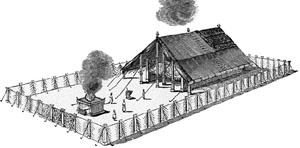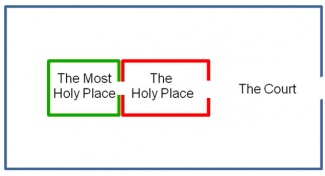William Branham and the nature of God: Difference between revisions
No edit summary |
|||
| Line 83: | Line 83: | ||
==Jesus Christ== | ==Jesus Christ== | ||
:''I said, "Yes, He was Divine. He was the created Son of God." And I said, "God was in Him reconciling the world to Himself."<ref>THE.RESURRECTION.OF.LAZARUS_ ERIE.PA SUNDAY_ 51-0729A</ref> | :''I said, "Yes, He was Divine. '''He was the created Son of God'''." And I said, "God was in Him reconciling the world to Himself."<ref>THE.RESURRECTION.OF.LAZARUS_ ERIE.PA SUNDAY_ 51-0729A</ref> | ||
:''Now notice! And after then the wise men identifying Him what He would be, and we find through the Scripture that's exactly what He was: Deity in service for death. What for? Deity in service to God for death. Jesus was Deity in service for death, to redeem the world. But what did the world do to It? They refused It. They rejected It. Why? Some of them, a big part of them, did that because this: because He did die! They said, "He couldn't be Deity and die." '''The Man (the body) was not Deity, but Deity was in the body'''. This body has to perish. The very Christ that's in you is the only thing that can raise you up. That's Deity, God in you.<ref>GOD'S.GIFTS.ALWAYS.FIND.THEIR.PLACES_ JEFF.IN V-6 N-13 SUNDAY_ 63-1222</ref> | |||
:''Now notice! And after then the wise men identifying Him what He would be, and we find through the Scripture that's exactly what He was: Deity in service for death. What for? Deity in service to God for death. Jesus was Deity in service for death, to redeem the world. But what did the world do to It? They refused It. They rejected It. Why? Some of them, a big part of them, did that because this: because He did die! They said, "He couldn't be Deity and die." The Man (the body) was not Deity, but Deity was in the body. This body has to perish. The very Christ that's in you is the only thing that can raise you up. That's Deity, God in you.<ref>GOD'S.GIFTS.ALWAYS.FIND.THEIR.PLACES_ JEFF.IN V-6 N-13 SUNDAY_ 63-1222</ref> | |||
=The Tabernacle of the Body= | =The Tabernacle of the Body= | ||
Revision as of 05:03, 7 June 2013
|
This article summarizes William Branham's teaching on the Godhead. Godhead means “the nature of God”[1], but is usually a term for “what” God is, rather than “who” God is. At its greatest depth, knowing about someone is much less rewarding that knowing someone. Still, it is a start. We do not spend time in this article highlighting the problems with William Branham's beliefs. The purpose of this article is simply to highlight what he believed. Other articles in this series, which can be accessed from the tabs at the top of the page, attempt to point out specific problem areas with William Branham's belief system. The Godhead and RespectIn the past, some Christians in positions of power have persecuted heretics (or anyone who disagrees with their own favourite doctrine). But persecuting heretics is as spiritual as stoning the good Samaritan. The treatment of the Cathars at the hands of the Catholics, most notably in the massacre in Beziers in 1209 A.D., is a historic example of this persecution. The Apostle Paul wrote about people who "hold the truth in unrighteousness" (Romans 1). He describes people who understand the Godhead correctly, but still choose to live a life of corruption. Paul’s final description of these individuals is ‘unmerciful’, which is an apt description of Arnaud-Amaury, the Catholic ambassador to the Cathars of Bezier, who declared “Kill them all, the Lord will recognise His own.” Jesus taught that only those who had a pure heart would see God (Matthew 5:8). Jesus’ zeal for the condition of the heart was matched only by his zeal for the Temple of God, driving out the moneychangers and saying, “My house shall be called the house of prayer; but ye have made it a den of thieves.” (Matthew 21:13) The temple was a place designed by God for worship, and is a symbol of Jesus Christ – through whom we have access by one Spirit unto the Father. William Branham's Continuously Changing View of the GodheadWilliam Branham was ordained as an exhorter in the Pentecostal Baptist Church (see article on Roy Davis) and, early in his ministry, believed in the Trinity as evidenced by the following: THE.RESURRECTION.OF.LAZARUS ERIE.PA 51-0729A
EARLY.SPIRITUAL.EXPERIENCES_ HAMMOND.IN SUNDAY_ 52-0713A
THE.TESTIMONY.OF.JESUS.CHRIST_ CHICAGO.IL SATURDAY_ 53-0829
In his early ministry, William Branham was very inclusive and extended open arms to both Trinitarians and Oneness believers (see the vision of the Plum and Apple Trees. In his sermon, The Godhead Explained, William Branham tells of when he was confronted by ministers of both the Assemblies of God (Trinitarian) and the United Pentecostal Church (Oneness) and forced to clearly define his doctrine. At the end of their discussion, William Branham had both representatives acknowledge that the other had the Holy Spirit. He then explained his method of baptism, which both representatives accepted. In this same sermon, William Branham tells of another confrontation with a UPC minister. This minister said "You know what we are going to do? We are drawing a little ring and drawing you right out of our circle." William Branham responded, "If you draw me out, I will draw you back in." While William Branham's view of the Godhead was hard to accurately pin down, he did appear to have changed his beliefs fundamentally on this subject in 1958, as his last reference to a Trinitarian understanding of the Godhead was in March 1958. He gradually became less and less tolerant of the Trinitarian view until he eventually classified anyone that believed in the Trinity doctrine as a non-Christian:
What William Branham BelievedWilliam Branham's teachings on the Godhead were all over the map. As a result, this is one of the areas that most message believers apply the doctrine of Progressive Revelation. William Branham stated many times that both the Oneness and Trinitarians were wrong and that the truth was somewhere in between. IS.THIS.THE.SIGN.OF.THE.END.SIR_ JEFF.IN V-2 N-11 SUNDAY_ 62-1230E
CALLING.JESUS.ON.THE.SCENE CHICAGO.IL 63-0804E
Jesus Christ
The Tabernacle of the BodyWhen you distill everything down, it appears that William Branham taught a view of the Godhead that was most similar to that taught by Emmanual Swedenborg. The Bible teaches that Christians are temples of the Holy Spirit. William Branham compared the temple in the Bible to a person, linking your physical body to the temple court, your spirit to the Holy place, and your soul to the Most Holy place. Each fully functioning human being has these three parts, but your soul is the temple of the Holy Spirit.
As support for his teaching, William Branham used the following scriptures:
The problem with this reasoning is that none of these scriptures deal with the Godhead. Using these as support for William Branham's view of the Godhead requires very oblique reasoning.
The order of the Tabernacle
Swedenborg and Branham argued that dividing God into three persons would be like dividing the tabernacle into three temples. Over-unifying God (denying his three-fold being, or saying God is one like your finger) is like having all of the pieces to the tabernacle in one big circle. Both of these ideas are out of order with God’s original design.
God’s original design given to Moses was that the Court surrounded The Holy Place, through which the high priest could access the Most Holy Place. In the same way, it is through the sacrifice of Jesus Christ (the Court) that we have access through his Spirit (the Holy Place) to the head of Christ, which is God (the Most Holy Place). Here is a more detailed description of the operation of the tabernacle and its parallel to Jesus Christ:
Footnotes
|

